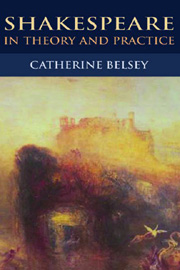Book contents
- Frontmatter
- Contents
- Preface
- 1 Introduction: Practising with Theory
- 2 Psychoanalysis and Early Modern Culture: Lacan with Augustine and Montaigne
- 3 Love as Trompe-l'oeil: Taxonomies of Desire in Venus and Adonis
- 4 Tarquin Dispossessed: Expropriation and Consent in The Rape of Lucrece
- 5 Antinomies of Desire and the Sonnets
- 6 Peter Quince's Ballad: Memory, Psychoanalysis, History and A Midsummer Night's Dream
- 7 The Illusion of Empire: Elizabethan Expansionism and Shakespeare's Second Tetralogy
- 8 Making Histories Then and Now: Shakespeare from Richard II to Henry V
- 9 The Case of Hamlet's Conscience
- 10 Iago the Essayist
- Notes
- Index
1 - Introduction: Practising with Theory
Published online by Cambridge University Press: 12 September 2012
- Frontmatter
- Contents
- Preface
- 1 Introduction: Practising with Theory
- 2 Psychoanalysis and Early Modern Culture: Lacan with Augustine and Montaigne
- 3 Love as Trompe-l'oeil: Taxonomies of Desire in Venus and Adonis
- 4 Tarquin Dispossessed: Expropriation and Consent in The Rape of Lucrece
- 5 Antinomies of Desire and the Sonnets
- 6 Peter Quince's Ballad: Memory, Psychoanalysis, History and A Midsummer Night's Dream
- 7 The Illusion of Empire: Elizabethan Expansionism and Shakespeare's Second Tetralogy
- 8 Making Histories Then and Now: Shakespeare from Richard II to Henry V
- 9 The Case of Hamlet's Conscience
- 10 Iago the Essayist
- Notes
- Index
Summary
Practice puts theory to the test. I have always been a practitioner first and foremost, valuing theory in so far as it delivers a different way of reading. Interpretation is only to a degree intuitive: we can learn to do it in new ways. Most children are able to paraphrase a story and say where their sympathies lie; critics do this too, but with recourse to a vocabulary that specifies how and why. In addition, however, just as in daily life we commonly signify more than we intend, give ourselves away, as the saying goes, so texts too may reveal more than their authors supposed. Theory has encouraged me to look more closely – to pay more attention.
At the same time, ‘theory’ is anything but a monolith. These essays were written at intervals in the course of four distinct decades, and if the most recent of them belongs to the present, the earliest was composed in an intellectual and institutional setting we should barely recognise now. Few generations can have witnessed greater upheavals in the theory and practice of interpretation than mine. In 1974, when I was writing Chapter 9, ‘The Case of Hamlet's Conscience’, English departments acknowledged no ‘theory’ in the current sense of the term. Courses on literary theory traced its development from Aristotle through Sidney and Dr Johnson to I. A. Richards; by way of current thinking, they respectfully reiterated the pronouncements of Keats, Matthew Arnold and T. S. Eliot. Northrop Frye was admired for his idiosyncratic structuralism but as something of a maverick.
- Type
- Chapter
- Information
- Shakespeare in Theory and Practice , pp. 1 - 14Publisher: Edinburgh University PressPrint publication year: 2008



